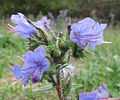Echium vulgare
- See also Viper's Bugloss (moth) for the insect.
| Viper's Bugloss | |
|---|---|
.jpg) | |
| Viper's Bugloss in flower | |
| Scientific classification | |
| Kingdom: | Plantae |
| (unranked): | Angiosperms |
| (unranked): | Eudicots |
| (unranked): | Asterids |
| Order: | Boraginales |
| Family: | Boraginaceae |
| Genus: | Echium |
| Species: | E. vulgare |
| Binomial name | |
| Echium vulgare L. | |
Echium vulgare (Viper's Bugloss or Blueweed)[1] is a species of Echium native to most of Europe, and western and central Asia.[2][3] It is also common in North America.[1]
It is a biennial or monocarpic perennial plant growing to 30–80 cm (12–31 in) tall, with rough, hairy, lanceolate leaves. The flowers start pink and turn vivid blue and are 15–20 mm (0.59–0.79 in) in a branched spike, with all the stamens protruding. The pollen is blue[4] but the filaments of the stamens remain red, contrasting against the blue flowers. It flowers between May and September. It is found in dry, bare and waste places.[5]
It has been introduced to North America and is naturalised in parts of the continent, being listed as an invasive species in Washington.[3]
Gallery
-
Viper's Bugloss being pollinated by skipper butterflies
-

Illustration of Echium vulgare
-

Closeup of flower
-

Viper's Bugloss colonizing the banks of a city highway
See also
- Monofloral honey
- Northern Nectar Sources for Honeybees
References
- ↑ 1.0 1.1 Dickinson, T.; Metsger, D.; Bull, J.; & Dickinson, R. (2004) ROM Field Guide to Wildflowers of Ontario. Toronto:Royal Ontario Museum, p. 203.
- ↑ Flora Europaea: Echium vulgare
- ↑ 3.0 3.1 Germplasm Resources Information Network: Echium vulgare
- ↑ Dorothy Hodges (1952). The pollen loads of the honeybee. Bee Research Association Ltd., London.
- ↑ Fitter, R. & A. (1974). The Wild Flowers of Britain and Northern Europe. Collins.
| Wikimedia Commons has media related to Echium vulgare. |
| ||||||
